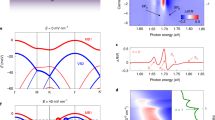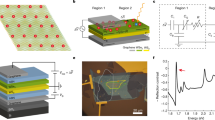Abstract
Two-dimensional materials and their heterostructures constitute a promising platform to study correlated electronic states, as well as the many-body physics of excitons. Transport measurements on twisted graphene bilayers have revealed a plethora of intertwined electronic phases, including Mott insulators, strange metals and superconductors1,2,3,4,5. However, signatures of such strong electronic correlations in optical spectroscopy have hitherto remained unexplored. Here we present experiments showing how excitons that are dynamically screened by itinerant electrons to form exciton-polarons6,7 can be used as a spectroscopic tool to investigate interaction-induced incompressible states of electrons. We study a molybdenum diselenide/hexagonal boron nitride/molybdenum diselenide heterostructure that exhibits a long-period moiré superlattice, as evidenced by coherent hole-tunnelling-mediated avoided crossings of an intralayer exciton with three interlayer exciton resonances separated by about five millielectronvolts. For electron densities corresponding to half-filling of the lowest moiré subband, we observe strong layer pseudospin paramagnetism, demonstrated by an abrupt transfer of all the (roughly 1,500) electrons from one molybdenum diselenide layer to the other on application of a small perpendicular electric field. Remarkably, the electronic state at half-filling of each molybdenum diselenide layer is resilient towards charge redistribution by the applied electric field, demonstrating an incompressible Mott-like state of electrons. Our experiments demonstrate that optical spectroscopy provides a powerful tool for investigating strongly correlated electron physics in the bulk and paves the way for investigating Bose–Fermi mixtures of degenerate electrons and dipolar excitons.
This is a preview of subscription content, access via your institution
Access options
Access Nature and 54 other Nature Portfolio journals
Get Nature+, our best-value online-access subscription
$29.99 / 30 days
cancel any time
Subscribe to this journal
Receive 51 print issues and online access
$199.00 per year
only $3.90 per issue
Buy this article
- Purchase on Springer Link
- Instant access to full article PDF
Prices may be subject to local taxes which are calculated during checkout





Similar content being viewed by others
Data availability
The data that support the findings of this study are available in the ETH Research Collection (http://hdl.handle.net/20.500.11850/399579).
References
Cao, Y. et al. Unconventional superconductivity in magic-angle graphene superlattices. Nature 556, 43–50 (2018).
Yankowitz, M. et al. Tuning superconductivity in twisted bilayer graphene. Science 363, 1059–1064 (2019).
Liu, X. et al. Spin-polarized correlated insulator and superconductor in twisted double bilayer graphene. Preprint at http://arxiv.org/abs/1903.08130 (2019).
Sharpe, A. L. et al. Emergent ferromagnetism near three-quarters filling in twisted bilayer graphene. Science 365, 605–608 (2019).
Lu, X. et al. Superconductors, orbital magnets and correlated states in magic-angle bilayer graphene. Nature 574, 653–657 (2019).
Sidler, M. et al. Fermi polaron-polaritons in charge-tunable atomically thin semiconductors. Nat. Phys. 13, 255–261 (2017).
Efimkin, D. K. & MacDonald, A. H. Many-body theory of trion absorption features in two-dimensional semiconductors. Phys. Rev. B 95, 035417 (2017).
Yu, H., Liu, G.-B., Tang, J., Xu, X. & Yao, W. Moiré excitons: from programmable quantum emitter arrays to spin-orbit–coupled artificial lattices. Sci. Adv. 3, e1701696 (2017).
Wu, F., Lovorn, T. & MacDonald, A. Topological exciton bands in moiré heterojunctions. Phys. Rev. Lett. 118, 147401 (2017).
Wu, F., Lovorn, T., Tutuc, E. & MacDonald, A. H. Hubbard model physics in transition metal dichalcogenide moiré bands. Phys. Rev. Lett. 121, 026402 (2018).
Ruiz-Tijerina, D. A. & Fal’ko, V. I. Interlayer hybridization and moiré superlattice minibands for electrons and excitons in heterobilayers of transition-metal dichalcogenides. Phys. Rev. B 99, 125424 (2019).
Rivera, P. et al. Interlayer valley excitons in heterobilayers of transition metal dichalcogenides. Nat. Nanotechnol. 13, 1004–1015 (2018).
Seyler, K. L. et al. Signatures of moiré-trapped valley excitons in MoSe2/WSe2 heterobilayers. Nature 567, 66–70 (2019).
Tran, K. et al. Evidence for moiré excitons in van der Waals heterostructures. Nature 567, 71–75 (2019).
Alexeev, E. M. et al. Resonantly hybridized excitons in moiré superlattices in van der Waals heterostructures. Nature 567, 81–86 (2019); correction 572, E8 (2019).
Jin, C. et al. Observation of moiré excitons in WSe2/WS2 heterostructure superlattices. Nature 567, 76–80 (2019); correction 569, E7 (2019).
Wang, Z. et al. Evidence of high-temperature exciton condensation in two-dimensional atomic double layers. Nature 574, 76–80 (2019).
Gerber, I. C. et al. Interlayer excitons in bilayer MoS2 with strong oscillator strength up to room temperature. Phys. Rev. B 99, 035443 (2019).
Zheng, L., Ortalano, M. W. & Das Sarma, S. Exchange instabilities in semiconductor double-quantum-well systems. Phys. Rev. B 55, 4506–4515 (1997).
Ezawa, Z. F. Quantum Hall Effects: Field Theoretical Approach and Related Topics (World Scientific, 2000).
Zhang, Y. et al. Direct observation of the transition from indirect to direct bandgap in atomically thin epitaxial MoSe2. Nat. Nanotechnol. 9, 111–115 (2014).
Özçelik, V. O., Azadani, J. G., Yang, C., Koester, S. J. & Low, T. Band alignment of two-dimensional semiconductors for designing heterostructures with momentum space matching. Phys. Rev. B 94, 035125 (2016).
Xu, X., Yao, W., Xiao, D. & Heinz, T. F. Spin and pseudospins in layered transition metal dichalcogenides. Nat. Phys. 10, 343–350 (2014).
Back, P. et al. Giant paramagnetism-induced valley polarization of electrons in charge-tunable monolayer MoSe2. Phys. Rev. Lett. 118, 237404 (2017).
Smoleński, T. et al. Interaction-induced Shubnikov–de Haas oscillations in optical conductivity of monolayer MoSe2. Phys. Rev. Lett. 123, 097403 (2019).
Hanson, R., Kouwenhoven, L. P., Petta, J. R., Tarucha, S. & Vandersypen, L. M. K. Spins in few-electron quantum dots. Rev. Mod. Phys. 79, 1217–1265 (2007).
Eisenstein, J. P., Pfeiffer, L. N. & West, K. W. Compressibility of the two-dimensional electron gas: measurements of the zero-field exchange energy and fractional quantum Hall gap. Phys. Rev. B 50, 1760–1778 (1994).
Hunt, B. M. et al. Direct measurement of discrete valley and orbital quantum numbers in bilayer graphene. Nat. Commun. 8, 948 (2017).
Imada, M., Fujimori, A. & Tokura, Y. Metal-insulator transitions. Rev. Mod. Phys. 70, 1039–1263 (1998).
Camjayi, A., Haule, K., Dobrosavljević, V. & Kotliar, G. Coulomb correlations and the Wigner–Mott transition. Nat. Phys. 4, 932–935 (2008).
Zarenia, M., Neilson, D. & Peeters, F. M. Inhomogeneous phases in coupled electron-hole bilayer graphene sheets: charge density waves and coupled Wigner crystals. Sci. Rep. 7, 11510 (2017).
Ludwig, D., Floerchinger, S., Moroz, S. & Wetterich, C. Quantum phase transition in Bose–Fermi mixtures. Phys. Rev. A 84, 033629 (2011).
Laussy, F. P., Kavokin, A. V. & Shelykh, I. A. Exciton-polariton mediated superconductivity. Phys. Rev. Lett. 104, 106402 (2010).
Wang, L. et al. One-dimensional electrical contact to a two-dimensional material. Science 342, 614–617 (2013).
Kim, K. et al. van der Waals heterostructures with high accuracy rotational alignment. Nano Lett. 16, 1989–1995 (2016).
Catellani, A., Posternak, M., Baldereschi, A. & Freeman, A. J. Bulk and surface electronic structure of hexagonal boron nitride. Phys. Rev. B 36, 6105–6111 (1987).
Laturia, A., Van de Put, M. L. & Vandenberghe, W. G. Dielectric properties of hexagonal boron nitride and transition metal dichalcogenides: from monolayer to bulk. npj 2D Mater. Appl. 2, 6 (2018).
Larentis, S. et al. Large effective mass and interaction-enhanced Zeeman splitting of K-valley electrons in MoSe2. Phys. Rev. B 97, 201407 (2018).
Rytova, N. S. The screened potential of a point charge in a thin film. Moscow Univ. Phys. Bull. 22, 18–21 (1967).
Lu, C.-P., Li, G., Watanabe, K., Taniguchi, T. & Andrei, E. Y. MoS2: choice substrate for accessing and tuning the electronic properties of graphene. Phys. Rev. Lett. 113, 156804 (2014).
He, K., Poole, C., Mak, K. F. & Shan, J. Experimental demonstration of continuous electronic structure tuning via strain in atomically thin MoS2. Nano Lett. 13, 2931–2936 (2013).
Conley, H. J. et al. Bandgap engineering of strained monolayer and bilayer MoS2. Nano Lett. 13, 3626–3630 (2013).
Zhu, C. R. et al. Strain tuning of optical emission energy and polarization in monolayer and bilayer MoS2. Phys. Rev. B 88, 121301 (2013).
Frisenda, R. et al. Biaxial strain tuning of the optical properties of single-layer transition metal dichalcogenides. npj 2D Mater. Appl. 1, 10 (2017).
Giannozzi, P. et al. QUANTUM ESPRESSO: a modular and open-source software project for quantum simulations of materials. J. Phys. Condens. Matter 21, 395502 (2009).
Dal Corso, A. Pseudopotentials periodic table: from H to Pu. Comput. Mater. Sci. 95, 337–350 (2014).
Rasmussen, F. A. & Thygesen, K. S. Computational 2D materials database: electronic structure of transition-metal dichalcogenides and oxides. J. Phys. Chem. C 119, 13169–13183 (2015).
Zollner, K., Faria, P. E. Jr & Fabian, J. Proximity exchange effects in MoSe2 and WSe2 heterostructures with CrI3: twist angle, layer, and gate dependence. Phys. Rev. B 100, 085128 (2019).
Acknowledgements
We acknowledge discussions with E. Demler, R. Schmidt, T. Smolenski, A. Popert and P. Knüppel. This work was supported by the Swiss National Science Foundation (SNSF) under grant number 200021-178909/1 and the European Research Council (ERC) Advanced Investigator Grant (POLTDES). Y.S. acknowledges support from the Japan Society for the Promotion of Science (JSPS) overseas research fellowships. K.W. and T.T. acknowledge support from the Elemental Strategy Initiative conducted by MEXT, Japan, A3 Foresight by JSPS and CREST (grant number JPMJCR15F3) and JST.
Author information
Authors and Affiliations
Contributions
Y.S. and I.S. carried out the measurements. Y.S. designed and fabricated the sample. M.K. helped to prepare the experimental setup. K.W. and T.T. grew the hBN crystal. Y.S. performed DFT calculation. Y.S., I.S. and A.I. wrote the manuscript. A.I. supervised the project.
Corresponding authors
Ethics declarations
Competing interests
The authors declare no competing interests.
Additional information
Peer review information Nature thanks Wang Yao and the other, anonymous, reviewer(s) for their contribution to the peer review of this work.
Publisher’s note Springer Nature remains neutral with regard to jurisdictional claims in published maps and institutional affiliations.
Extended data figures and tables
Extended Data Fig. 1 Optical microscope image of the device.
The border of each flake is highlighted with dashed lines, and the material is indicated in the grey box with the corresponding colour. Gr, graphene.
Extended Data Fig. 2 Effect of twist angle and strain on moiré periodicity.
a, Plot of the relation between twist angle and strain difference which gives same moiré periodicity (λmoiré), shown for λmoiré from 20 to 30 nm. b, Strain difference dependence of moiré periodicity for a fixed twist angle of 0.8°.
Extended Data Fig. 3 Band structure of R-stacked MoSe2/hBN/MoSe2 heterostructure obtained from DFT calculation.
a–c, The side and top view of the supercell for \({{\rm{R}}}_{{\rm{h}}}^{{\rm{h}}}\) (a), \({{\rm{R}}}_{{\rm{h}}}^{{\rm{X}}}\) (b) and \({{\rm{R}}}_{{\rm{h}}}^{{\rm{M}}}\) (c) used for the calculation. d–f, The calculated band structure of R-stacked MoSe2/hBN/MoSe2 for \({{\rm{R}}}_{{\rm{h}}}^{{\rm{h}}}\) (d), \({{\rm{R}}}_{{\rm{h}}}^{{\rm{X}}}\) (e) and \({{\rm{R}}}_{{\rm{h}}}^{{\rm{M}}}\) (f) lattice displacement. The insets show the magnified plot of the valence bands around the γ point.
Supplementary information
Supplementary Information
This file contains Supplementary Information sections 1–8 including Supplementary Figures 1–10.
Rights and permissions
About this article
Cite this article
Shimazaki, Y., Schwartz, I., Watanabe, K. et al. Strongly correlated electrons and hybrid excitons in a moiré heterostructure. Nature 580, 472–477 (2020). https://doi.org/10.1038/s41586-020-2191-2
Received:
Accepted:
Published:
Issue Date:
DOI: https://doi.org/10.1038/s41586-020-2191-2
This article is cited by
-
Probing many-body correlations using quantum-cascade correlation spectroscopy
Nature Physics (2024)
-
Terahertz linear/non-linear anomalous Hall conductivity of moiré TMD hetero-nanoribbons as topological valleytronics materials
Scientific Reports (2024)
-
Atomic-scale visualization of the interlayer Rydberg exciton complex in moiré heterostructures
Nature Communications (2024)
-
Heterostructures coupling ultrathin metal carbides and chalcogenides
Nature Materials (2024)
-
Observation of spin polarons in a frustrated moiré Hubbard system
Nature Physics (2024)
Comments
By submitting a comment you agree to abide by our Terms and Community Guidelines. If you find something abusive or that does not comply with our terms or guidelines please flag it as inappropriate.



